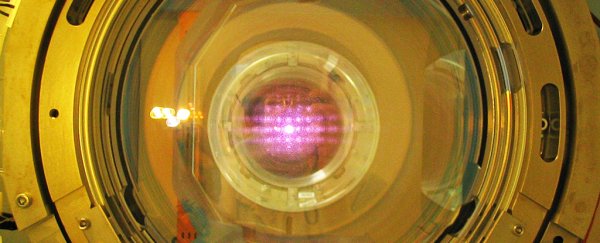Plasma, that super-hot mix of electrified atomic particles, plays a key role in the evolution of stars, black holes, and other cosmic elements. For closer study though, plasma needs to be recreated in a lab – and researchers have just managed to generate a particular type of plasma jet for the first time.
The key characteristics of this lab-created plasma jet are its stability and its magnetism. Further study of the jet could help us unlock some more of the secrets of the Universe.
Not only that, the scientists were able to run some advanced diagnostics on the jet – getting readings for its density, temperature, length, coherence, and magnetic field – which helps them better compare it to plasma out in space.
"We are now creating stable, supersonic, and strongly magnetised plasma jets in a laboratory that might allow us to study astrophysical objects light years away," says one of the team leaders, astrophysicist Edison Liang from Rice University in Texas.
The researchers trained 20 individual laser beams into a circular shape on a plastic target to produce puffs of plasma, which were then pressurised as they expanded to create a plasma jet four millimetres (0.16 inches) in length, with a magnetic field strength of over 100 tesla (about 10,000 times stronger than a small bar magnet).
Those original laser beams weren't any ordinary lights, though – they were produced by the OMEGA laser at the Laboratory for Laser Energetics, part of the University of Rochester in New York. It's one of the most powerful lasers in the world, capable of focussing huge energy bursts on very small targets.
Thanks to the diagnostic work the researchers carried out on the plasma jet, they now have a baseline to use to see how the plasma reacts under different conditions.
Future tests will involve different types of plasma-related phenomena, such as using an external magnetic field to see if the jet grows in size and becomes more collimated (with parallel rays).
The researchers also want to try the same experiment with the National Ignition Facility at Lawrence Livermore National Laboratory, which has no fewer than 192 laser beams – half of those could contribute to the plasma laser ring.
"It would have a larger radius and thus produce a longer jet than that produced using OMEGA," says one of the lead researchers, physicist Lan Gao from the Princeton Plasma Physics Laboratory (PPPL). "This process would help us figure out under which conditions the plasma jet is strongest."
The circle method the researchers developed here has the potential to scale up very well, the researchers say, and is similar to the plasma offshoots that might be observed from a newborn star – only easier to study up close.
As the research continues, we should learn more about this special state of matter and the role it plays in the wider cosmos (as well as any ordinary microwave, if the right conditions are met).
"This is groundbreaking research because no other team has successfully launched a supersonic, narrowly beamed jet that carries such a strong magnetic field, extending to significant distances," says Liang.
"This is the first time that scientists have demonstrated that the magnetic field does not just wrap around the jet, but also extends parallel to the jet's axis."
The research has been published in Astrophysical Journal Letters.
